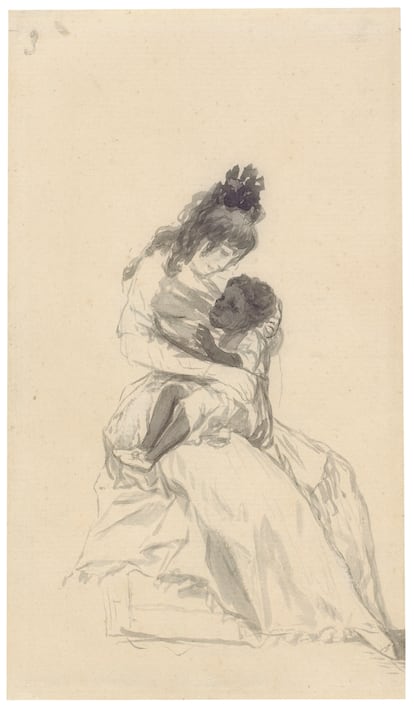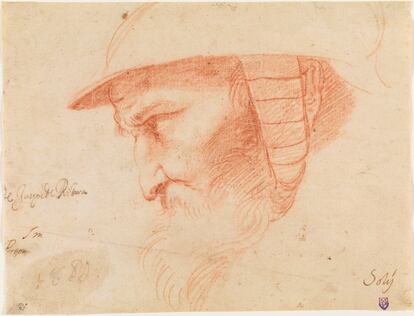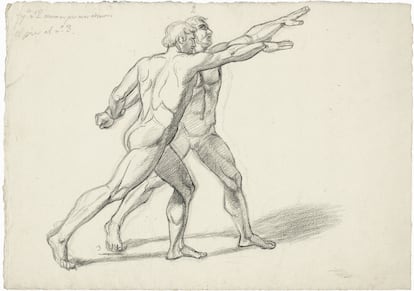The secrets of the Prado Museum never end, it is an infinite surprise. When the drawings of José de Madrazo (1781-1859) are shown these days in room 60, next spring the art gallery will exhibit in its spaces, on furniture designed specifically, drawings, prints and photographs that improve knowledge of the works of the gallery; We will also see drawings, among the canvases or sculptures, that helped in their creation or are related to them and, with their classic discretion, they are working on finishing the volumes of Goya’s complete drawings, both those preserved in Spain and abroad. The criterion is to present a sample of this technique—not just the master’s—every year. There will be prints, photos, and those traces, almost secret until now, can finally be enjoyed by visitors.
Suddenly, drawing, which in Spain, unfortunately, has had an image of a “utilitarian” art, regains its value. “It is a reality that there are few preserved ones and those that have reached us are very mistreated,” reflects José Manuel Matilla, head of Conservation of Drawings and Prints. But they are beginning to resurface. The gallery has 10,000 drawings, between 7,000 and 8,000 prints and about 20,000 photographs. These numbers are still far from the collections of the Louvre, the New York Met or the Uffizi. Although within these funds, the most important correspond to the so-called “Spanish collection”. Carducho, Alonso Cano, Ribalta, Claudio Coello, Carreño de Miranda, Rosales. And, of course, Ribera and Goya. Before we get to them, some little-known gems. The only drawing that exists (Main chapel of San Juan de los Reyes) by Juan Guas and two brief notes (first attributed, and although, without a doubt, original) by Miguel Ángel (Study of man’s right arm and Study of man’s right shoulder, chest and upper arm) for the Sistine Chapel and dated between 1536 and 1541. They were part of a sheet with a larger number of images, but at one point in history they were cut to be sold in sections and earn more money. The last time they were shown in the museum was in 2004. It’s been 20 years.
The origin of the collection is almost strata of fortuitous times. Many came from the royal workshops, foreign artists (Giordano, Mengs or Tiepolo) entered with the Bourbons, the then Trinidad Museum (mainly contributed works by Goya) and, also, thanks to Pedro Fernández Durán (1846-1930) , who donated his collection, among them, the Michelangelo. Another gem: the only surviving drawing by Fernando Lema (1752-1810), a gift from a retired museum curator.
Prado knows that despite the number there are spaces that must be filled. The museum is Goya’s home and the genius is his priority. It houses about 500 drawings, half of his second production. The rest have been dispersed throughout Europe and the United States and only the famous one conceived during his trip to Italy in 1770 is preserved in its entirety. He was 24 years old and learned the trade based on copies or architectural notes. But there are more. The renowned expert Eleanor Sayre cataloged them with capital letters, which does not mean that others could exist. “A”, “B”, “C”, “D”, “E”, “F”, “G” and “H”. All incomplete. Drawings are missing. “From the second half of the 19th century onwards they dispersed,” says Matilla.
Javier Goya (son of the painter), Mariano de Goya (his only grandson), or the Madrazo saga conceived a way to profit. They invented albums “for rent,” Matilla confirms, in which they mixed original drawings with photos and prints. A Artistic Frankenstein. Over time, one of his almost complete albums was recovered, coming from Trinidad. But it was too late. Hundreds of drawings had been lost. “That’s why we have a clear acquisition policy: we buy, I won’t say a lot – because we suffer from the law of supply and demand – but, above all, in Spain – where it is more affordable than in the international market -: what appears by Goya. With him there are no restrictions.”
They are also acquiring artists’ notebooks. They have more than a hundred. “The notebooks are still subject to the risk of dismemberment. A single sheet is worth nothing, a notebook is worth everything,” emphasizes the person in charge of drawing at the Prado. The works, by the way, are exhibited in what they call “Moneo wooden frames” (There are three sizes: small, medium and large and they come horizontally and vertically).

Another artist whose drawings are being recovered is Ribera (1591-1652). A few years ago there were only six with a secure attribution. The painter was also a master in drawing. Extraordinary. From Gabriele Finaldi’s 2016 exhibition (José de Ribera. Drawings) the number is close to a hundred. With the same criterion of purchasing in Spain because out there the price is very high for any work signed by The Españoleto (his nickname). “But, neither with Ribera nor with any other artist, anything matters to us: either they are very good drawings or they must be related to works in the museum. The lines of incorporations are perfectly marked,” clarifies the curator.
And the transportation and care rules are identical to the paintings. They always travel with a courier and a police escort, the temperature fluctuates above 20 degrees and the humidity is around 45%, but they have an enormous limitation. They can only be exposed (at about 30 or 40 lux, a measure of illumination) for a maximum of three months, then they will go back into darkness, inside boxes that do not have acidity, for about four years before being shown again. . And in this, the Prado is inflexible. Furthermore, it is only lent to museums with which there is trust, as long as the project has the maximum curatorial and technical guarantees. “Because, for example, Goya is worth a torn and unstitched piece,” says Mantilla. “That can’t be.”

The uncertain debate of the drawings refers to time. How long will the paper live? Despite the new techniques: will they end up becoming cellulose molecules? Centuries, art, history, will heritage end up being lost? In another room, the paper restoration room, expert Minako Wada awaits. “The ideal,” he comments, “would be for all the drawings to be restored; However, it is impossible due to the amount of funds and new acquisitions.” He has been in the house for more than a decade. “We try to make the drawings last 400 more years, but it is something that no one can guarantee. Hopefully. However, nothing lasts forever. Our objective is based on prolonging their life, in a stable way, as much as possible,” he assumes. Perhaps there is no artistic expression like drawing that reminds human beings of the finitude of their life.

